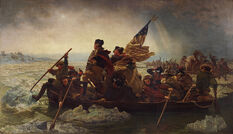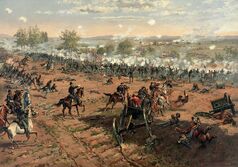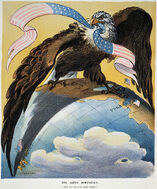| |||||||
| Anthem | "The Star Spangled Banner" | ||||||
| Capital | Washington, D.C. | ||||||
| Largest city | New York City | ||||||
| Other cities | Boston, Philadelphia, Baltimore, Chicago, Miami, Los Angeles, San Francisco, Seattle, Honolulu, San Juan, Dallas, Houston, Atlanta | ||||||
| Language official |
English | ||||||
| others | Spanish, French, German, Dutch | ||||||
| Religion | Christianity | ||||||
| Demonym | American | ||||||
| Government | Federal presidential constitutional republic | ||||||
| President | Paul Ryan | ||||||
| Vice President | Bobby Jindal | ||||||
| Area main |
9,842,624 km2 | ||||||
| water (%) | 8.57 | ||||||
| Population | 328,776,496 | ||||||
| Independence | from Great Britain | ||||||
| declared | July 4, 1776 | ||||||
| recognized | September 3, 1783 | ||||||
| Currency | US Dollar (USD, $) | ||||||
| Organizations | UN, NATO, OAS, ANZUS | ||||||
The United States of America (USA), commonly referred to as the United States (U.S.) or America, is a federal republic composed of 51 states, a federal district, four major territories and various other possessions. The 48 contiguous states and Washington, D.C., are in central North America between Canada and Mexico. The state of Alaska is in the northwestern part of North America, the state of Hawaii is an archipelago in the mid-Pacific, and the state of Puerto Rico (admitted in 2013) is located in the Caribbean, next to the U.S. Virgin Islands.
The United States emerged from the British 13 colonies on the East Coast. On July 4, 1776, as the colonies were fighting Great Britain in the American Revolutionary War, delegates from the 13 colonies unanimously adopted the Declaration of Independence. The war ended in 1783 with recognition of the independence of the United States. The following centuries to come, the United States would expand southward and westward. The country became a military power after the Spanish-American War of 1898 and World War I. After the end of World War II, the U.S. became a global superpower in rivalry with the Soviet Union. This would eventually lead to the Cold War and World War III, in which the United States remains the world's sole superpower.
History[]
See also: History of the United States
Pre-history and Colonial Years[]
Long before civilization, it is believed that the early humans crossed from Asia to North America via the Bering Straits. These early humans would be the ancestors of the Native American tribes that roamed the North American continent. Before Christopher Columbus reached the Caribbean islands, it was the Vikings that were first able to reach the new world. From the 1600s-1700s, the British, French, Spanish, Dutch, and the Italians would already have settlements and colonies within North America.
Independence and beyond[]

The famous painting of George Washington crossing the Delaware River during the American Revolutionary War.
The United States emerged from the British 13 colonies on the East Coast. On July 4, 1776, as the colonies were fighting Great Britain in the American Revolutionary War, delegates from the 13 colonies unanimously adopted the Declaration of Independence. The war ended in 1783 with recognition of the independence of the United States by the Kingdom of Great Britain. The United States was then invaded by the British during the War of 1812 but the war ended with no territorial gains or losses. Guided by the principles of Manifest Destiny, the United States expanded westward and southward, purchasing French and Spanish territories in the North American continent along the way.

The Battle of Gettysburg.
The U.S. itself would fight a civil war with the Confederates in the South, who wished to secede from the United States over States' Rights in 1861, beginning with the state of South Carolina. The Confederates were defeated in 1865 and the U.S. continued to expand to the Pacific Coast.
Early to Mid-20th Century (1900-1946)[]

Political cartoon on American expansion from 1898-1901.
As the 1890s came to a close, the United States would emerge victorious in the Spanish-American War; earning itself the Spanish territories of the Philippines, Guam, Cuba, and Puerto Rico.
The beginning of the 20th Century, the U.S. strengthened their position in Asia. The U.S. Army intervened during the 1900 Boxer Rebellion in China. In 1915, the city of Tientsin was ceded to the United States as an overseas enclave but was ceded to the British two years later. During the early years of the First World War, the United States remained neutral up until the sinking of the Lusitania. In 1917, the United States entered the First World War and turned the tide against the Central Powers. The Wall Street Crash of 1929 entered the United States and the world into the Great Depression, which lasted throughout the rest of the 1930s. During the Inter-war years, the U.S. was involved in Central America in the Banana Wars, protecting American interests from local or European threats. In March 24, 1934, the Tydings-McDuffie Law was signed, permitting the independence of the Philippines after a 10 year transition period. The U.S. Navy and Marines was also deployed to protect American interests in China, such as the American concession in the Shanghai International Settlement, in the late 1930s as signs of Japanese aggression became imminent. Diplomatic relations with Japan soured after the USS Panay was sunk on Yangtze River by Japanese planes, killing three U.S. Navy sailors.

U.S. Marines in Okinawa, 1945.
Following the outbreak of World War II in Europe, the U.S. initially remained neutral but passed on the Lend-Lease Act, supplying the USSR, the United Kingdom, France, and China with weapons and war material. The U.S. entered World War II following the surprise attack on Pearl Harbor on December 7, 1941. Upon entry of the U.S. with subsequent landings in North Africa, the Japanese were pushed back in June 1942. By 1943, the Allied forces landed in Italy with the peninsula captured in 1944. The same year, Allied forces landed in Normandy and began their liberation of France - which was liberated in the August of 1944. Following the end of Christmas, the Allied forces were closing in to Germany. The Allies stopped west of the Elbe while the Soviet Union continued on to Berlin which they captured on May 2, 1945. Adolf Hitler committed suicide two days before. World War II ended in Europe on May 8, 1945 as Berlin was divided among the Americans, British, French and the Soviets. The war on the Pacific would end on September 2, 1945; a month after the United States dropped two atomic bombs on Hiroshima and Nagasaki. After the end of World War II, the Philippines became an independent country. Tensions with the Soviet Union ran high at this point. The United Nations was formed between the Allied Powers on June 26, 1945.
Cold War[]
See also: History of the United States (1945–64), History of the United States (1964–80), History of the United States prior to World War III
Following the period after the end of World War II, the world was divided into the democratic West and the communist East. Because of the large presence of Soviet troops along the Iron Curtain, the United States, Canada and several free Western European countries would form the North Atlantic Treaty Organization (NATO) as a counter measure. The Soviets in turn would create their own alliance with the communist Eastern European states known as the Warsaw Pact. The USSR would also create their own nuclear arsenal. Both the U.S. and the USSR would fight indirectly through proxy wars in Korea, Cuba, Vietnam, Angola, Grenada, and other nations affected by communist insurgencies from the 1950s to the early 1980s.

Cold War situation before World War III.
In 1985, relations with the Soviet Union gradually improved under Mikhail Gorbachev. This was continued after the end of the Ronald Reagan Administration. George H W Bush won the 1988 Presidential elections, vowing nuclear disarmament and improving relations with the Soviets. When Gorbachev was arrested in a coup staged by hardliners in 1987, the Soviet Union ramped up their military forces in the Iron Curtain and demanded economic aid from the Western European countries. The West, in turn, did not accept such terms in which peace conferences broke down in the Winter of 1988. It became clear that a Third World War was imminent; as more and more Soviet troops were massed along Eastern Europe. NATO prepared as well, but they could not match up with what preparations the Soviets were up to.
World War III[]
Coming soon
The 21st Century[]
Coming soon
Politics[]
Executive[]
Legislative[]
Judiciary[]
States[]
See also: List of U.S. States
The United States is composed of a union of 51 states stretching from the Atlantic Coast, the Gulf of Mexico, and the Pacific Ocean. The Continental/Contiguous United States (CONUS), also known as the U.S. Mainland, is composed of the lower 48 states.
Alaska is the only offshoot state located within mainland North America, sharing a land border with Yukon Province, Canada to the East and maritime borders with the Russian Federation to the West and the Arctic Circle. The states of Hawaii and Puerto Rico are the only two island states to be admitted to the Union. Hawaii is located in the middle of the north Pacific Ocean while Puerto Rico, the newest state, is located in the Caribbean Sea bordering several island nations and overseas territories of France and the United Kingdom.
Territories[]
See also: List of U.S. Territories
In addition to the 48 states on the mainland, the states of Hawaii, Alaska, and Puerto Rico; the United States possess 15 territories. The Territories of the United States are sub-national administrative divisions directly overseen by the United States federal government (unlike U.S. states, which share sovereignty with the federal government). The five major territories are self-governing with locally elected governors and territorial legislatures. Each also elects a non-voting delegate (or resident commissioner) to the House of Representatives.
These territories are administer by the Department of Interior. On July 4, 2013, the territory of Puerto Rico became the 51st state to be admitted to the Union.
Culture[]
Foreign Relations[]
The United States has diplomatic missions at almost all countries of the world. The international relations is handled by the U.S. State Department.
The United States is a permanent member of the United Nations, G7, and G20. The United States has a "special relationship" with the United Kingdom and strong ties with Canada, Australia, New Zealand, the Philippines, Japan, Korea, Israel, and several European Union countries, including France, Italy, Germany, and Spain. It works closely with fellow NATO members on military and security issues and with its neighbors through the Organization of American States (OAS).
| ||||||||||||||||||




